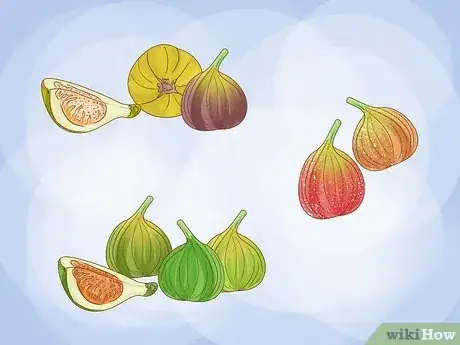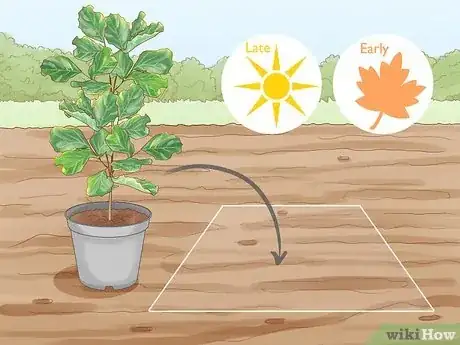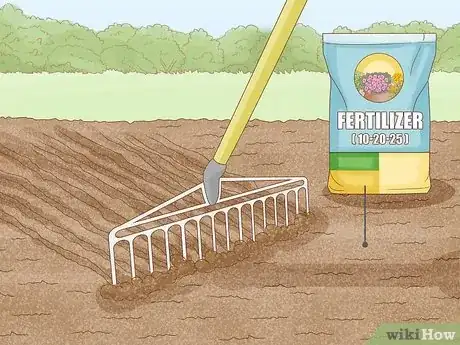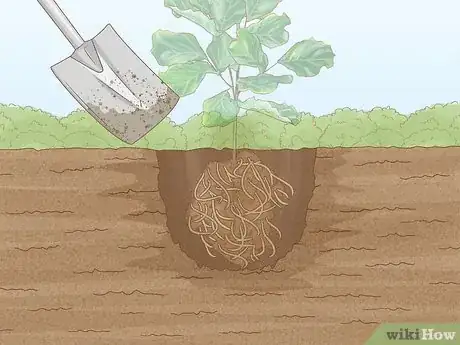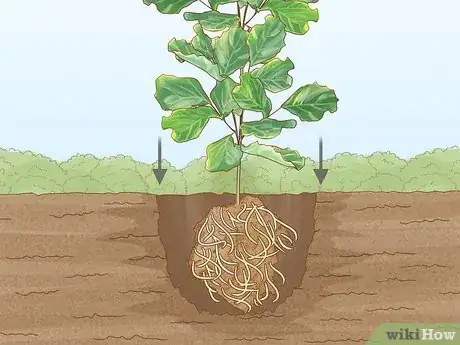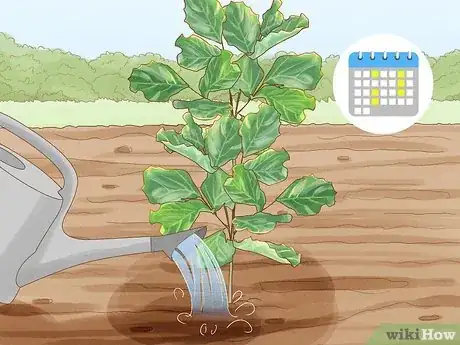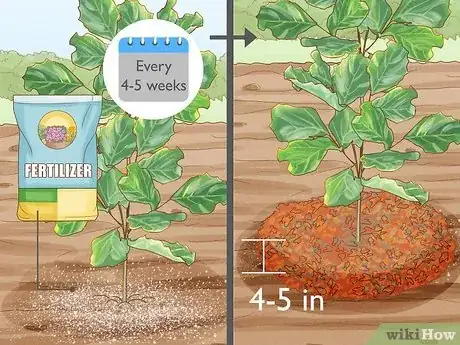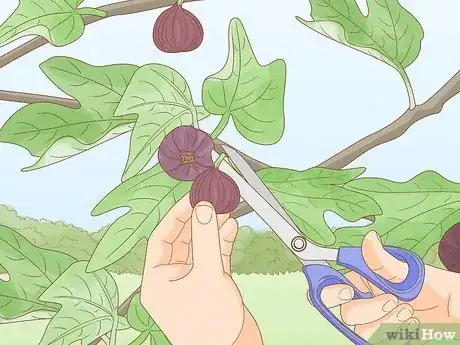This article was co-authored by Andrew Carberry, MPH. Andrew Carberry is a Food Systems Expert and the Senior Program Associate at the Wallace Centere at Winrock International in Little Rock, Arkansas. He has worked in food systems since 2008 and has experience working on farm-to-school projects, food safety programs, and working with local and state coalitions in Arkansas. He is a graduate of the College of William and Mary and holds a Masters degree in public health and nutrition from the University of Tennessee.
wikiHow marks an article as reader-approved once it receives enough positive feedback. In this case, 100% of readers who voted found the article helpful, earning it our reader-approved status.
This article has been viewed 87,487 times.
Figs are popular fruits that are eaten fresh or dried, and included in baked goods and preserves. Figs are grown from fig trees, and grow well in the southern and western United States (USDA hardiness zones 8-10), as well as Mediterranean and northern African locations, where climates are temperate and dry. Figs require warm weather and a lot of sunshine, and the trees grow large. Fig trees require a lot of space to grow and bloom.
Steps
Getting Ready
-
1Choose a variety of figs. There are many types of figs available on the market, but there are a few common ones that are very popular for their hardiness. Look into the figs that grow best in your region, but consider varieties like brown turkey, Brunswick, or Osborne figs. Keep in mind that figs come in varying colors, in shades from purple to green to brown. Each type of fig typically ripens at a different type of the year as well.[1]
- Visit a local nursery or call your local agricultural extension to get figs that are suitable for your local climate.
- Figs grow best in warm, tropical and desert-like areas, so the largest variety of figs will be able to grow in these environments. Only a select few species can grow in places whose temperatures drop below 40 °F (4 °C).
-
2Know when to plant. In general, figs should be planted in mid spring. A young fig tree will take up to two years to produce its first fruit, but typically the figs ripen in late summer and early fall. Pruning should also occur in the summer, which is atypical to some other popular fruit trees.Advertisement
-
3Decide where to plant. Because fig trees are so cold-sensitive and also require maintenance of the root ball, it is typically easiest to plant them in a pot if you are growing them in a climate any colder than USDA hardiness zone 7. This way, they can be moved to warmer areas and their roots can be easily maintained. However, you can choose to plant your figs outside with the right conditions; find a location on a southern-facing slope with minimal shade and plenty of drainage.
-
4Prepare the soil. Although fig trees aren’t particularly picky about soil conditions, they do thrive with a few minor changes. In general, fig trees grow best in soil that is slightly sandy and with a pH near 7 or just below (more alkaline). Add a bit of fertilizer to the soil in a 4-8-12 or 10-20-25 mix or mulch with a layer of compost.[2]
Planting Your Fig Tree
-
1Prepare your plot. Use a small shovel or your hands to dig a hole for your fig tree. Make the hole just large enough for the root ball to fit, and plant the tree at the same level it was growing in the container.
-
2Plant your tree. Remove the plant from the container and carefully put it on its side. Use a pair of gardening shears to trim off the excess roots around the edges, as these reduce fruit production. Then, place the root ball in the hole and spread the roots carefully away from the trunk. Fill in the areas beneath and around the tree with soil, and pat the soil so it is even and firm.[3]
-
3Water the fig tree. To help your newly planted tree to settle, give them a heavy watering for a few days. However, in general figs don’t like a ton of water, so give your tree a moderate amount of water 1-2 times a week after planting.
-
4Maintain the soil. If you planted your fig tree outside, it is important that you maintain the soil and plot that the plant is growing in. Pull any weeds that you see, and replenish the soil with fertilizer every 4-5 weeks. Additionally, apply between 4 and 6 inches of mulch around the trunk of the tree, covering the soil evenly.
- Keep in mind that trees planted in containers are more dependent on fertilizer, and they need to be fertilized once per month.
- Mulching in the summer will preserve moisture. Mulching in the winter will protect the figs from cold and frost.
-
5Prune your figs when necessary. Prune your fig tree in the summer of the second year, as it is not necessary to prune them during their first year of growth. Prune the branches down to 4 strong shoots, which will lead in the production of fruit. After the tree matures, prune back every spring before the figs begin to grow.
-
6Harvest the fruit. Harvest figs from the tree when they are completely ripe, as they will not continue to ripen after picking (like peaches). A ripe fig will be a little bit soft, and curved at the neck. The color of a ripe fig will vary depending on the variety you have, as figs come in many different colors. Remove the fruit from the tree gently to avoid bruising the fig.
- Wear gloves when picking your figs, as the sap from the tree (released during harvesting) is a natural skin irritant.[4]
Expert Q&A
Did you know you can get expert answers for this article?
Unlock expert answers by supporting wikiHow
-
QuestionCan a fig tree be grown from cuttings?
 Andrew Carberry, MPHAndrew Carberry is a Food Systems Expert and the Senior Program Associate at the Wallace Centere at Winrock International in Little Rock, Arkansas. He has worked in food systems since 2008 and has experience working on farm-to-school projects, food safety programs, and working with local and state coalitions in Arkansas. He is a graduate of the College of William and Mary and holds a Masters degree in public health and nutrition from the University of Tennessee.
Andrew Carberry, MPHAndrew Carberry is a Food Systems Expert and the Senior Program Associate at the Wallace Centere at Winrock International in Little Rock, Arkansas. He has worked in food systems since 2008 and has experience working on farm-to-school projects, food safety programs, and working with local and state coalitions in Arkansas. He is a graduate of the College of William and Mary and holds a Masters degree in public health and nutrition from the University of Tennessee.
Food Systems Expert
-
QuestionWhich are the best fig cultivars for growing figs in home gardens?
 Andrew Carberry, MPHAndrew Carberry is a Food Systems Expert and the Senior Program Associate at the Wallace Centere at Winrock International in Little Rock, Arkansas. He has worked in food systems since 2008 and has experience working on farm-to-school projects, food safety programs, and working with local and state coalitions in Arkansas. He is a graduate of the College of William and Mary and holds a Masters degree in public health and nutrition from the University of Tennessee.
Andrew Carberry, MPHAndrew Carberry is a Food Systems Expert and the Senior Program Associate at the Wallace Centere at Winrock International in Little Rock, Arkansas. He has worked in food systems since 2008 and has experience working on farm-to-school projects, food safety programs, and working with local and state coalitions in Arkansas. He is a graduate of the College of William and Mary and holds a Masters degree in public health and nutrition from the University of Tennessee.
Food Systems Expert
-
QuestionI bought a house with a fig tree two years ago. We have had no fruit. What can I do?
 Community AnswerCut the tree back to 2 or 3 strong branches.
Community AnswerCut the tree back to 2 or 3 strong branches.
Warnings
- Remember to wear gloves when pruning or harvesting figs. Sap that comes off of fig trees can be irritating to skin.⧼thumbs_response⧽
References
About This Article
To plant a fig tree, start by tilling the soil in a large pot with mulch or compost around mid-spring, and then dig a hole large enough to fit the root ball of the plant. Trim the excess roots around the edges of the root ball, and place it in the hole, carefully spreading the roots away from the trunk. Water the plant heavily for 2-3 days after planting, and reduce watering to 1-2 times per week after that. After 2 years of growing, prune the branches back to encourage fruit growth. Harvest the figs when they’re soft to the touch by pulling them gently off the branch. To learn more from our Food Systems Expert co-author, like how to prepare the soil for a fig tree, keep reading!
